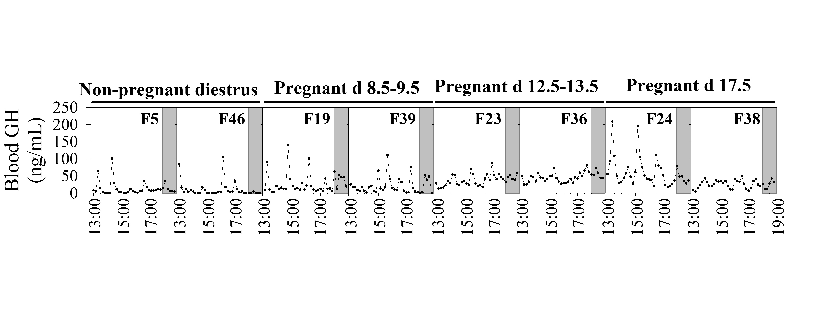Poster Presentation Annual Meetings of the Endocrine Society of Australia and Society for Reproductive Biology and Australia and New Zealand Bone and Mineral Society 2016
Pulsatile GH profiles in the pregnant mouse reveal marked increases in circulating GH and GH secretion between early and mid-pregnancy (#353)
Maternal growth hormone plays an important role in adaptation to pregnancy. In humans, increasing placental GH secretion progressively suppresses pulses of GH secretion from the pituitary by mid-gestation. Consequently, circulating GH in human pregnancy is pulsatile during implantation and early pregnancy, and less variable and elevated in the second half of pregnancy (1). Both concentrations and pattern of GH determine its actions, but neither have been characterised in pregnancy in mouse, an important species for biomedical research. We therefore characterised circulating GH profiles in non-pregnant diestrus C57B6/J mice (n=9) and in time-mated mice in early pregnancy (d8.5-9.5 after mating, n=8), at mid-pregnancy (d12.5-13.5, n=7) and late pregnancy (d17.5, n=6). Blood GH was measured by highly-sensitive GH ELISA and secretion parameters assessed by deconvolution analysis (3). Circulating blood GH remained pulsatile (Figure) and pulse frequency and secretion were stable throughout pregnancy in the mouse.

Figure. Representative blood GH profiles in non-pregnant diestrus mice and throughout murine pregnancy
Mean blood GH concentrations, and total and basal GH secretion were each similar in non-pregnant and early pregnant mice (all P>0.1), increased markedly between early and mid-pregnancy (all P<0.01), and were similar in mid- and late-pregnant mice (all P>0.1). Thus, circulating GH increases in mouse during the second half of pregnancy, similar to changes in human pregnancy. The timing of this increase in circulating GH corresponds to formation of the chorioallantoic placenta and initiation of maternal blood flow through the murine placenta (2), and suggests that placental signals stimulate basal pituitary GH secretion during pregnancy in the mouse.
- Eriksson L, Frankenne F, Eden S, Hennen G, and Vonschoultz B. Growth-hormone secretory profiles in pregnancy - lack of pulsatility for the secretion of the placental variant. Br J Obstet Gynaecol 96: 949-953, 1989.
- Pringle KG, and Roberts CT. New light on early post-implantation pregnancy in the mouse: roles for insulin-like growth factor-II (IGF-II)? Placenta 28: 286-297, 2007.
- Steyn FJ, Huang L, Ngo ST, Leong JW, Tan HY, Xie TY, Parlow AF, Veldhuis JD, Waters MJ, and Chen C. Development of a method for the determination of pulsatile growth hormone secretion in mice. Endocrinology 152: 3165-3171, 2011.